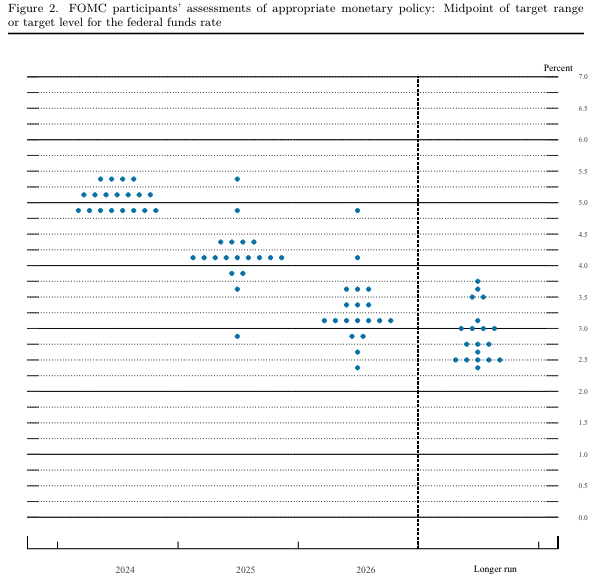The Fed just penciled in only one interest rate cut this year—but officials are divided on policy
After a cooler-than-expected inflation report helped stocks surge Wednesday morning, all eyes shifted to the Federal Reserve for its highly anticipated interest-rate decision.
The central bank decided to hold rates steady at the June Federal Open Market Committee (FOMC) meeting, a move that was widely anticipated by Wall Street. But the new “dot plot,” which represents FOMC officials’ interest-rate projections for each of the next three years in a matrix grid, showed a median forecast for just one interest rate cut in 2024, compared with three in March. The Fed also projected slightly higher inflation ahead, and in order to cut rates, Fed Chair Jerome Powell said he needs to see “more good data” that confirms inflation is truly under control.
Investors didn’t seem too spooked by the hawkish change in the Fed’s outlook, however, partly because many forecasters already had fewer than three rate cuts penciled in for this year. The Dow Jones industrial average fell just 0.09% on Wednesday, while the S&P 500 rose 0.85% and the tech-heavy Nasdaq surged 1.53%.
“Don’t take too much direction from today’s FOMC ‘dot plot,’” Ronald Temple, chief market strategist at Lazard, told Fortune via email. “As additional inflation and labor reports through the summer reaffirm that price pressures are decreasing and labor market tightness is easing, I expect FOMC members to reassess their forecasts yet again to include more rate cuts by year-end.”
David Russell, global head of market strategy at TradeStation, backed up that outlook. “This is a nothing-burger Fed meeting,” he told Fortune via email. “They know conditions are improving, but don’t need to rush with rate cuts … Goldilocks is emerging, but policymakers don’t want to jinx it.”
To Russell and Temple’s point, the latest Fed meeting may not have been as hawkish as the dot plot projections suggest. The only major change in the monetary policy statement, which accompanies the Fed’s rate outlook, was the replacement of the words “a lack of” with “modest” before the discussion of further progress toward the Fed’s 2% inflation target, for example. And Powell told reporters in his follow-up press conference that “we’ve made pretty good progress on inflation,” noting that Wednesday’s consumer price index report was “encouraging.”
The Fed is also still projecting a significant decline in interest rates over the next three years. Officials expect the Fed funds rate to drop from 5.1% in 2024 to 4.1% in 2025, and then to 3.1% in 2026. These projections, as always, are subject to change, but they’re evidence that the Fed hasn’t shifted its dovish view entirely.
The bond market is still pricing in a 60% chance of a rate cut in September as well, according to Fed futures contracts compiled by CME’s FedWatch Tool. That’s below the 70% peak seen after the cool inflation report Wednesday morning, but 10 percentage points above Tuesday’s reading.
In a dovish moment, Powell also hinted that recent strong jobs numbers might be slightly “overstated,” pushing aside some experts’ concerns about persistent wage growth caused by the strong labor market leading to stubborn inflation.
“We see gradual cooling, gradual moving toward better balance,” Powell said, adding that it’s still “a very strong labor market, but not the superheated labor market of two years ago, or even one year ago.”
Another reason markets might be discounting the Fed’s hawkish dot plot is the disparity between Fed officials’ interest rate projections. While seven officials are projecting one rate cut this year, four see no cuts—up from two in March—and eight see two cuts.

Overall, both professional investors and economists seem to view the latest Fed meeting as nothing but a reiteration of the central bank officials’ mostly dovish, yet staunchly data-dependent stance, which promises they’ll adapt to new data and remain nimble with policy decisions.
“The Fed made their decision-making process fairly clear coming into today’s meeting, and their policymakers are reacting to incoming data in a manner that is consistent with that process,” Bill Adams, Comerica Bank’s chief economist, told Fortune via email. “If inflation continues to moderate, as has been the trend over the last year and a half, the Fed will start to cut interest rates in the second half of 2024.”
Finally, while Wall Street will undoubtedly continue to agonize over the Fed’s projections and tone in future meetings, Powell hinted that the investor class might be reading too far into small potential moves in interest rates.
“If you look back in five or 10 years and try to pull out the significance to the U.S. economy of one 25-basis-point cut, you’d have quite a job on your hands,” he said.
This story was originally featured on Fortune.com

 Yahoo Finance
Yahoo Finance 